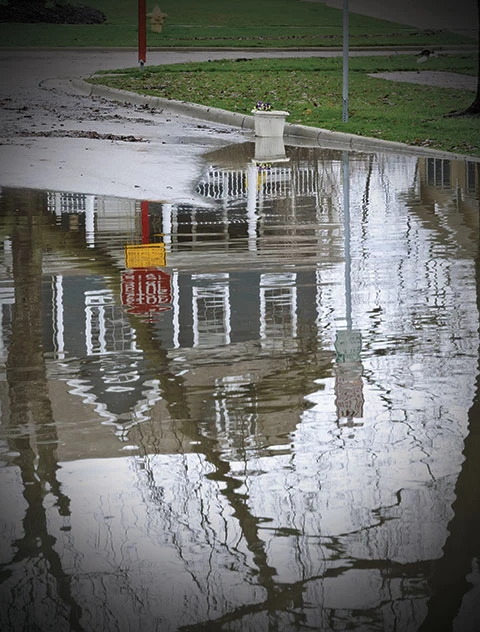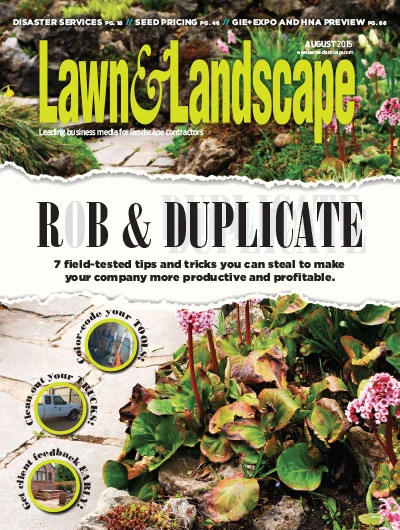
There’s a calm following a storm, but there’s nothing low-key about the disaster response required to get a landscape back into shape. Tree damage, flooded spaces, debris and infrastructural damage can be left in the wake, and it’s not pretty. But landscape firms that take on cleanup work know this, and they come prepared.
This month, Lawn & Landscape spoke with three firms that tackle different aspects of storm cleanup, disaster response and prevention like preparing a landscape to handle floodwaters and more. Here’s what they had to say about the resources, labor and skills it takes to perform these services successfully.
.jpg) Natural solutions
Natural solutions
A major flood in the fall of 2013 turned Longmont, Colo., into a virtual island. Bridges were washed out and properties were destroyed. A few days later, President Khalana Gocken took flyers to a neighborhood facing a filthy aftermath that felt overwhelming to residents. She only spent a few hours knocking on doors to share information about her services at Ethos Landscape and Design. “These poor people were trying to figure out if they could even save their houses,” she says, adding the hard approach just felt predatory.
So she started offering people insight instead. “I gave advice about what they could do moving forward, and that made me feel better, and I decided from then on I was going to make sure that my clients don’t have to experience this, or that (damage) is limited.”
Some of the areas Ethos Landscape serves are flood plains. Aside from flood disasters, which are not a regular occurrence, heavy rains and storms can wash out properties if adequate infrastructure is not in place. And Gocken isn’t talking to clients about traditional setups like French drains. “You can only fit so much water through a 4-inch pipe,” she says.
Instead, she’s having conversations with clients about rain gardens, dry creek beds and other natural solutions for managing erosion, storm water run-off and even finding ways to trap water on properties to help feed the soil and plants. In the municipalities she serves, no one is allowed to collect rainwater.
Gocken admits she’s not a traditional landscape maintenance and design firm. She previously owned a firm like that before deciding to take this sustainable approach a few years ago. “It kind of takes an open mind and a little bit of faith on our clients’ part to start down the road with us,” Gocken says. “We do a lot of explaining. We explain the way nature deals with issues (like storm water and flooding). And nature does it beautifully.”
And Gocken shares examples of how a preventive approach to managing floodwaters and run-off can benefit clients – and what happens without these solutions in place. “I had one client who had just dug a foundation to build a home, and as the water was running down a hill from other properties, it became a swimming pool – it was crazy,” she says. “After that, I said, ‘OK. We are getting you a rain garden and deep-rooted plants that can deal with this water as it is running off so it does not collect on your property and create problems for you.”
Once clients try one of Gocken’s natural solutions, they often call with gratitude. “They say, ‘We went outside after that rain storm and it worked,’” she says.
So Gocken doesn’t rush in to sell cleanup services. Instead, she teaches how soil rebuilding and other techniques can set up clients for success when storms do strike. This way of considering how we manage water and seeking alternatives is a long-term approach, she says. “This is where the industry will be heading in the next 20 years. There will be no other option.”
Scaling sales
 Andrew Bachman turned what he considered a serious deficit in the storm cleanup process into a business niche for Trout Brook Landscaping in West Hartford, Conn. Following a big storm, trained arborists and landscape professionals with the equipment and skills to handle tree work don’t have time to prospect or sell services. They just want to do the work.
Andrew Bachman turned what he considered a serious deficit in the storm cleanup process into a business niche for Trout Brook Landscaping in West Hartford, Conn. Following a big storm, trained arborists and landscape professionals with the equipment and skills to handle tree work don’t have time to prospect or sell services. They just want to do the work.
“It doesn’t make sense for these companies that have the equipment to also manage the projects and do sales at the same time,” Bachman says. “They make more money hiring a sales person to do the face time with customers.”
Bachman is the face time.
But Trout Brook does more than sell in the eye of the storm. Holding four arborist certifications, and owning a landscaping firm of his own, he brings skill and consultation services to clients who need guidance so they can restore their properties back to a usable state.
“There are not enough people who can provide a quality consultation to homeowners and businesses for tree work following storms,” Bachman says of filling a niche.
Trout Brook’s emergency response role is to assess situations and propose plans of action. This includes meeting with the property owner, calling in insurance companies to assess and secure structural damage, and then essentially designing a project scope for a qualified contractor to execute. “We are the sales team, so when we go to a storm, we do prospecting calls and customer traction,” Bachman explains, adding that securing sales is specialized work. Not every tree company thrives in this area, which is why they can hire Bachman to be the sales arm. “Disaster response, or storm-chasing, requires an attentive, detail-oriented salesperson,” he says.
Bachman cut his teeth in this area while working on major disaster response projects in 2011. Hurricane Irene tore through New York and southern Connecticut, and two months later a Halloween snowstorm, Alfred, dumped a foot of heavy, wet snow on the region.
“There were tree branches breaking all over town, and some trees fell over entirely,” he says. “There were contractors coming in from all over the country – the government actually requested for tree contractors to make their way out to Connecticut to help out.”
During that time, Bachman connected with a cable television contractor with 35 years of storm experience and two bucket trucks. Bachman learned from this mentor, and they served on a contractor team post-Hurricane Sandy, clearing right-of-way roadways in northeast New Jersey.
“During that time, we connected with others on the FEMA project and others from prior storms,” Bachman says of the network of tree contractors and other professionals on site. “There is a huge need for qualified contractors for this type of work.”
And there’s an even greater need for qualified professionals to communicate with customers and draft plans for managing the cleanup. Bachman says his strength is sales.
While his company owns a bucket truck and does residential tree work for his client base, along with landscape maintenance and installation, he chooses to spend post-storm man-hours doing sales.
“That way, we are nimble and we don’t have to bring equipment with us when we do storm work now,” he says. “We are agents of the companies we sell the work for.” Bachman takes a sales commission off storm work sold. These sales vary depending on the year. During Hurricane Sandy, storm sales accounted for 30 percent of Trout Brook’s revenues.
“I was doing that work for two and a half months during that winter,” he says.
 Thunderstorms in the spring 2014 resulted in storm sales of about 5 percent of revenue that year. In 2015, snowstorms produced roof clearance jobs. Bachman saw an opportunity to put the bucket truck and his professional tree climber to work. Those sales (his company did all of the labor) amounted to 10 percent of revenue so far.
Thunderstorms in the spring 2014 resulted in storm sales of about 5 percent of revenue that year. In 2015, snowstorms produced roof clearance jobs. Bachman saw an opportunity to put the bucket truck and his professional tree climber to work. Those sales (his company did all of the labor) amounted to 10 percent of revenue so far.
Bachman’s storm business is all about focusing on his strength in sales, while maintaining a strong base business serving his clients’ landscaping needs.
“This is the angle of storm business where we find the most profit,” he says.
Landscape the levees
Rebuilding the Big Easy after Hurricane Katrina required significant infrastructural investments, and government dollars flooded in to New Orleans to aid the cause. Working as a subcontractor to a large civil contractor, Mullin Landscape Associates performed some work installing “levee armory,” which requires laying down sod or hydroseeding significant stretches of land.
Mullin Landscape Associates met a tight deadline, earning recognition as part of a larger contractor team as first to finish their portion of levee armory. Doing so required resources – mainly available labor that could be assigned to this project while the rest of crews maintained the company’s regular accounts and kept other design/build projects moving.
“These companies (civil engineering) want to know they can draw from a large labor pool,” Mullin says. Aside from labor, a business must be able to front the cash flow for materials and labor until payment comes in – and that’s almost never until after projects are completed when the government is paying the tab. “That can cause a headache for smaller companies,” Mullin says.
Mullin says the bulk of post-Katrina rebuilding projects were initiated shortly after the disaster, but there’s still work to be done. Mullin Landscape Associates is currently on two project sites. The larger of the two has been in progress for about a year, and Mullin estimates a good six more months of time before completion. In the end, the levee armory project involving hydroseeding work will be about a $250,000 project, performed in stages over time.
Overall, hurricane recovery work makes up a small portion of the business – much less than 10 percent, Mullin says. And while government jobs tend to be primarily price-driven, and Mullin likes to stay away from projects driven only by dollars, he says the civil contractors that bring on Mullin Landscape Associates appreciate the value he brings, even if Mullin Landscape Associates’ price isn’t the lowest.
But beyond revenues, these disaster rebuilding jobs can provide some positive visibility, Mullin adds. “The project we’re doing now is on a busy stretch of road along the Mississippi River, and we have our truck and a hydroseeding machine on that levee,” he says. “That can help people realize the capabilities we have as a company.”

Explore the August 2015 Issue
Check out more from this issue and find your next story to read.
Latest from Lawn & Landscape
- Connect, Control & Conserve with Horizon Technical Services
- Use Horizon's Parts Hotline
- How I built a Top 100 company
- Horizon’s Exclusive TurfGro Fertilizer
- Grow your business with mosquito control
- LandCare adds 2 branches in SoCal, promotes Aleman to branch manager
- Spray them away
- PERC helps debut propane direct-injection fuel system at ACT Expo 2025





